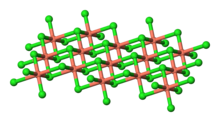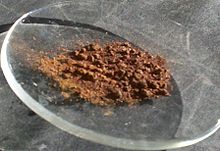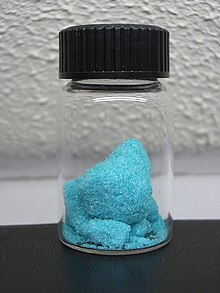 | |
 Anhydrous
| |
 Dihydrate
| |
| Names | |
|---|---|
| IUPAC name
Copper(II) chloride
| |
| Other names
Cupric chloride
| |
| Identifiers | |
| |
3D model (JSmol)
|
|
| 8128168 | |
| ChEBI | |
| ChEMBL | |
| ChemSpider | |
| DrugBank | |
| ECHA InfoCard | 100.028.373 |
| EC Number |
|
| 9300 | |
PubChem CID
|
|
| RTECS number |
|
| UNII |
|
| UN number | 2802 |
CompTox Dashboard (EPA)
|
|
| |
| |
| Properties | |
| CuCl2 | |
| Molar mass | 134.45 g/mol (anhydrous) 170.48 g/mol (dihydrate) |
| Appearance | dark brown solid (anhydrous) light blue solid (dihydrate) |
| Odor | odorless |
| Density | 3.386 g/cm3 (anhydrous) 2.51 g/cm3 (dihydrate) |
| Melting point | 630 °C (1,166 °F; 903 K) (extrapolated) 100 °C (dehydration of dihydrate) |
| Boiling point | 993 °C (1,819 °F; 1,266 K) (anhydrous, decomposes) |
| 70.6 g/(100 mL) (0 °C) 75.7 g/(100 mL) (25 °C) 107.9 g/(100 mL) (100 °C) | |
| Solubility | methanol: 68 g/(100 mL) (15 °C)
|
| +1080·10−6 cm3/mol | |
| Structure[1][2] | |
| monoclinic (β = 121°) (anhydrous) orthorhombic (dihydrate) | |
| C2/m (anhydrous) Pbmn (dihydrate) | |
a = 6.85 Å (anhydrous)
7.41 Å (dihydrate), b = 3.30 Å (anhydrous) 8.09 Å (dihydrate), c = 6.70 Å (anhydrous) 3.75 Å (dihydrate) | |
| Octahedral | |
| Hazards | |
| GHS labelling: | |
   
| |
| Danger | |
| H301, H302, H312, H315, H318, H319, H335, H410, H411 | |
| P261, P264, P270, P271, P273, P280, P301+P310, P301+P312, P302+P352, P304+P340, P305+P351+P338, P310, P312, P321, P322, P330, P332+P313, P337+P313, P362, P363, P391, P403+P233, P405, P501 | |
| NFPA 704 (fire diamond) | |
| Flash point | Non-flammable |
| NIOSH (US health exposure limits): | |
PEL (Permissible)
|
TWA 1 mg/m3 (as Cu)[3] |
REL (Recommended)
|
TWA 1 mg/m3 (as Cu)[3] |
IDLH (Immediate danger)
|
TWA 100 mg/m3 (as Cu)[3] |
| Safety data sheet (SDS) | Fisher Scientific |
| Related compounds | |
Other anions
|
Copper(II) fluoride Copper(II) bromide |
Other cations
|
Copper(I) chloride Silver chloride Gold(III) chloride |
Except where otherwise noted, data are given for materials in their standard state (at 25 °C [77 °F], 100 kPa).
| |
Copper(II) chloride, also known as cupric chloride, is an inorganic compound with the chemical formula CuCl2. The monoclinic yellowish-brown anhydrous form slowly absorbs moisture to form the orthorhombic blue-green dihydrate CuCl2·2H2O, with two water molecules of hydration. It is industrially produced for use as a co-catalyst in the Wacker process.
Both the anhydrous and the dihydrate forms occur naturally as the rare minerals tolbachite and eriochalcite, respectively.
- ^ A. F. Wells (1947). "The crystal structure of anhydrous cupric chloride, and the stereochemistry of the cupric atom". Journal of the Chemical Society: 1670–1675. doi:10.1039/JR9470001670.
- ^ Sydney Brownstein; Nam Fong Han; Eric Gabe; Yvon LePage (1989). "A redetermination of the crystal structure of cupric chloride dihydrate". Zeitschrift für Kristallographie. 189 (1): 13–15. Bibcode:1989ZK....189...13B. doi:10.1524/zkri.1989.189.1-2.13.
- ^ a b c NIOSH Pocket Guide to Chemical Hazards. "#0150". National Institute for Occupational Safety and Health (NIOSH).
